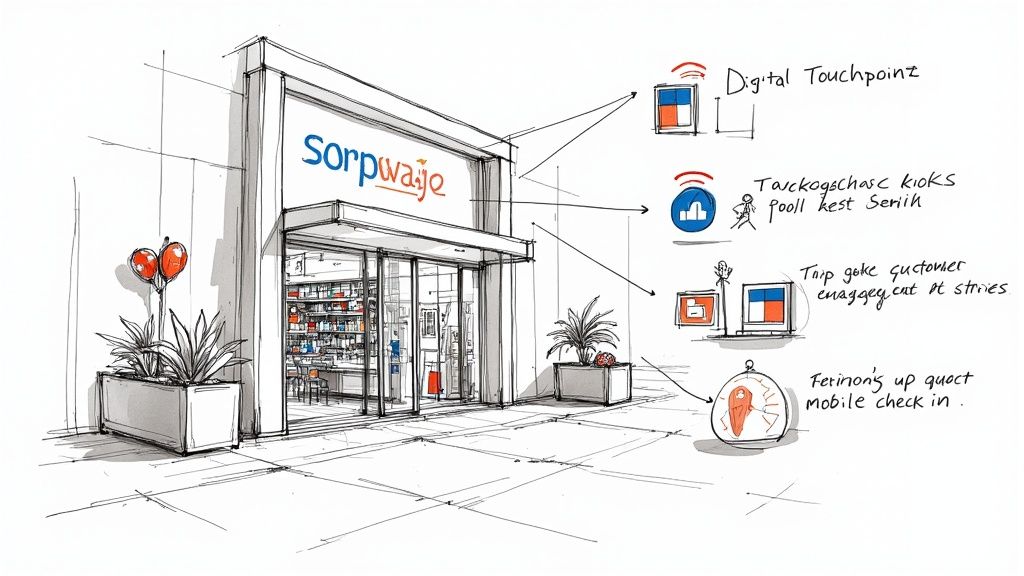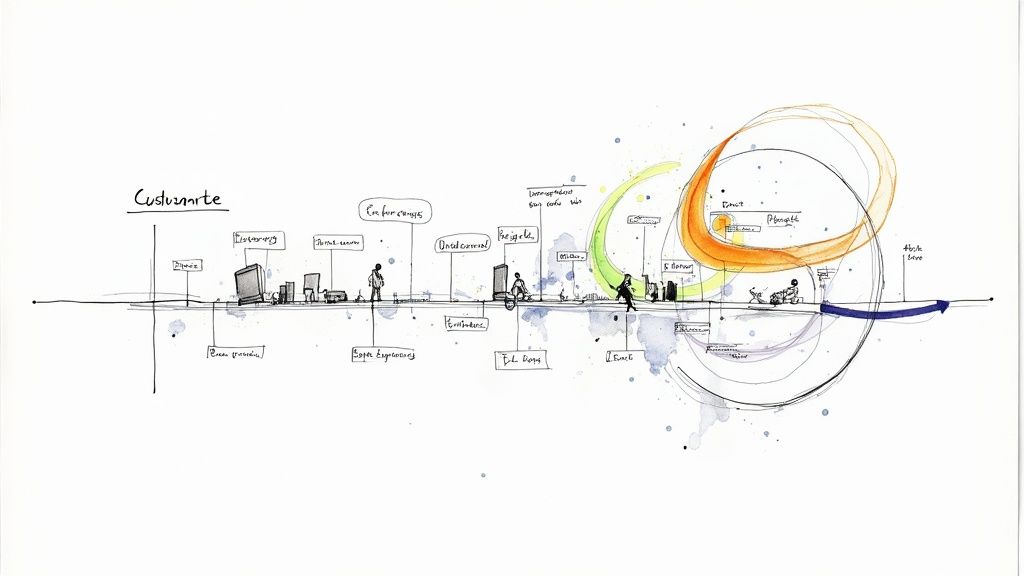How to Increase Customer Engagement: A Research-Backed Strategy Guide
Building the Foundation for Customer Connection

Building real customer connections takes more than just random touchpoints and interactions. While quick-fix tactics like batch emails and broad promotions might boost short-term metrics, they rarely create the kind of relationships that keep customers coming back. To truly engage customers, businesses need to focus on authenticity and making each interaction count. Today's customers want to feel like more than just another entry in a spreadsheet - they want genuine connections with the brands they choose.
Understanding the Modern Customer
Customers now have endless options at their fingertips, making it essential for businesses to stand out in meaningful ways. Research shows that 73% of people base their purchase decisions primarily on the quality of their customer experience. This explains why building strong relationships matters more than ever. Think about your local coffee shops - one sends generic promotional emails, while another remembers your name and favorite drink. The second creates a personal connection that keeps you coming back. These small but significant touches show how human connections drive customer loyalty.
The Power of Personalized Experiences
Real personalization goes far beyond just adding someone's name to an email template. It requires understanding individual preferences, challenges, and needs to create experiences that truly resonate. The business impact is clear - companies that effectively use customer data to personalize experiences see their revenue increase by 80%. Additionally, 88% of online shoppers are more likely to return to websites that remember their preferences and make relevant recommendations. These numbers reflect how much customers value experiences tailored to them as individuals.
Building a Customer-Centric Approach
Creating strong customer connections requires putting customers at the center of every business decision and interaction. Here are key strategies that make this approach work:
- Active Listening: Monitor and respond to customer feedback across all channels - from social media comments to support conversations. Use these insights to improve your products and service.
- Proactive Communication: Reach out to customers before they need help. Share useful information and solutions that make their lives easier.
- Community Building: Give customers spaces to connect with each other and your brand. This creates a sense of belonging that strengthens loyalty.
- Value Creation: Look beyond just selling products. Provide helpful content, resources and experiences that add real value to customers' lives.
When you focus on these core elements, you build the foundation for lasting customer relationships and loyalty. Moving from transaction-focused interactions to meaningful connections helps create a resilient brand that can adapt as markets and customer needs evolve. Most importantly, it creates the kind of authentic engagement that turns customers into long-term advocates for your business.
Mastering Real-Time Customer Response
The foundation we explored for connecting with customers is essential, but meeting modern expectations requires going a step further. Today's customers seek immediate responses and engagement from the businesses they interact with. Successfully managing real-time customer interactions has become fundamental to building and maintaining strong relationships with your audience.
Why Real-Time Matters More Than Ever
Consider this common scenario: You reach out to a business with an urgent question, only to wait hours or days for a response. This delay creates frustration and erodes trust. Recent studies show that 72% of customers now expect businesses to respond quickly to their inquiries. This isn't just about convenience - prompt responses make customers feel valued and heard. When businesses acknowledge and address customer needs quickly, it creates a positive emotional connection that strengthens loyalty.
Achieving High Satisfaction Through Strategic Response
Companies that excel at customer service consistently achieve 90% satisfaction rates by focusing on both speed and quality in their responses. The key is personalizing each interaction - using the customer's name, referencing their history with your business, and showing genuine interest in their specific situation. Data shows that when issues are resolved quickly and personally, customers are 2.4 times more likely to stay loyal to a brand. Additionally, 64% of customers say they're willing to spend more with companies that solve their problems efficiently through their preferred communication channels.
Balancing Automation with the Human Touch
While technology helps deliver quick responses at scale, finding the right mix of automated and human support is crucial. For example, Zendesk and similar platforms can handle routine questions automatically, freeing up your team to focus on more complex customer needs. But remember that automation should complement, not replace, human interaction. Think of it like a restaurant - while self-service kiosks might speed up ordering, you still want attentive servers available for special requests and personalized service.
Scaling Your Response Capabilities
Growing your business while maintaining excellent customer service requires careful planning. Here are proven approaches to scale effectively:
- Invest in the right technology: Choose tools that connect your various communication channels and allow smooth handoffs between automated systems and human agents
- Empower your team: Give your support staff thorough training and access to customer information so they can make informed decisions quickly
- Prioritize proactive communication: Get ahead of potential issues by reaching out to customers before problems arise - this reduces support volume while showing customers you're thinking about their needs
By putting these strategies into practice, businesses can create a responsive service system that truly engages customers. Making this investment in real-time support helps you stand out by consistently exceeding customer expectations rather than just meeting them.
Creating Personalized Customer Experiences That Convert

Great customer service isn't just about responding to questions anymore - it's about creating meaningful personal connections with customers before they even reach out. When businesses take time to understand individual preferences and craft experiences around them, casual browsers become loyal fans who keep coming back. The key is making personalization feel natural and valuable rather than forced or intrusive.
Understanding the Value of Personalization
Think about your favorite local coffee shop, where the barista remembers your usual order and asks about your day. That genuine personal connection makes you want to return, even if there are cheaper options nearby. Online businesses can create similar bonds - studies show that 88% of shoppers are more likely to revisit websites that remember their preferences and past interactions. When customers feel truly understood, they're more likely to engage and buy.
Implementing Effective Personalization Strategies
Real personalization goes beyond just using someone's name in an email. It means thoughtfully using customer data to create experiences that feel custom-made. This could mean sorting customers into groups based on what they buy and browse, then showing them relevant products and content. Just as Netflix suggests shows based on what you've watched before, smart product recommendations keep customers engaged because they actually match their interests.
Respecting Privacy While Personalizing
As important as personalization is, respecting customer privacy matters just as much. The best approach is being completely open about how you collect and use customer information. Let people know what data you're gathering and give them clear control over their preferences. Simple things like letting customers opt out of targeted ads show you value their choices. When you handle personal data responsibly, customers are more likely to trust and stay with your brand.
Segmentation and Content Customization: Key Elements of Personalization
Getting personalization right starts with understanding different customer groups and creating content just for them. By dividing your audience based on shared traits and behaviors, you can craft messages that really connect. This works across all channels - from email to social media. It's like how a good chef adjusts recipes based on diners' tastes and dietary needs. The more you study how different groups respond, the better you can fine-tune your approach. Over time, this builds stronger relationships that keep customers coming back and telling others about their great experiences with your brand.
Maximizing Impact Across Digital Channels
While personalized experiences and quick responses are essential, effective customer engagement requires meeting your audience on the channels they use most. Success comes from carefully selecting and optimizing the right mix of digital platforms, not just maintaining a basic presence everywhere.
Choosing the Right Channels for Your Audience
Finding the best channels starts with understanding exactly who your customers are and how they behave online. Think of it like planning a party - you want to host it where your guests will actually show up. If you're targeting business professionals, focusing on LinkedIn makes more sense than TikTok. This focused approach helps you invest time and resources where they'll have the biggest impact, rather than spreading yourself too thin across platforms that don't reach your core audience.
Adapting Content for Each Platform
Each platform has its own communication style and audience expectations. A detailed blog post that works well on your website needs to be reimagined as eye-catching visuals and brief text for Instagram. The key message stays consistent, but the format changes to match how people consume content on different channels. This thoughtful adaptation helps your content connect more effectively with users while maintaining your brand's voice.
Measuring and Optimizing Your Channel Performance
Regular monitoring tells you what's working and what needs adjustment. Keep track of important metrics like website visits, social engagement levels, and email performance. For example, if you notice your Facebook posts getting much more interaction than Twitter, it makes sense to focus more energy there. Let the data guide your decisions about where to concentrate your efforts for the best results.
Creating a Seamless Omnichannel Experience
Connect all your digital touchpoints so customers can move smoothly between them. Make it easy for website visitors to find your social profiles, and promote your email newsletter consistently across all platforms. When someone interacts with your brand, they should have a consistent experience whether they're on your website, social media, or reading your emails. This well-coordinated approach keeps customers engaged and coming back, as they know they'll get reliable, high-quality interactions no matter how they choose to connect with you.
Building a Customer-Obsessed Culture

Creating amazing digital experiences and quick responses helps keep customers engaged. But to make this work long-term, you need something deeper - a company culture that truly puts customers first. This means going beyond basic customer service to really understand what customers want and need at every level of your organization.
Aligning Your Teams Around the Customer
Most companies face a common challenge - different departments working separately with their own goals. The sales team chases deals, marketing focuses on leads, and customer service handles problems as they come up. Breaking down these walls is essential. Take a software company, for example - when developers understand the issues customers report to support, they can build features that work better for users. When everyone shares the same goal of making customers successful, engagement naturally improves.
Developing Supportive Internal Systems
Getting teams on the same page is just the start. Your staff needs the right tools to deliver great customer experiences. This could mean better communication tools, shared customer databases, or a good CRM system. It's like giving a chef quality ingredients and equipment - they need the proper resources to create something special. The same goes for your teams crafting excellent customer interactions.
Effective Team Training and Development
Building customer focus requires training that goes beyond product specs. Teams need to learn about customer psychology, communication skills, and handling tough situations with care. This investment really pays off - studies show companies with highly engaged employees beat their competition by 147% in earnings per share. This shows how internal culture directly impacts business success.
Measuring the Impact of Cultural Change
Want to know if your customer-focused culture is working? Keep an eye on key numbers like customer satisfaction scores, Net Promoter Score (NPS), customer churn rate, and employee satisfaction. These metrics show how cultural changes affect both customer engagement and business results. Regular monitoring helps you adjust your approach and proves the value of investing in customer focus. The data also helps convince internal teams of the benefits, keeping momentum strong as you build better customer relationships. This ongoing improvement helps you consistently exceed customer expectations and build lasting loyalty.
Measuring What Matters in Customer Engagement

When it comes to customer engagement, what you measure shapes what you achieve. While basic metrics like follower counts and website visits provide surface-level insights, they don't tell the full story of how effectively you're connecting with customers. To truly understand engagement's impact on your business, you need to focus on metrics that directly tie to customer loyalty and revenue growth. This means looking beyond raw numbers to evaluate the quality and depth of your customer interactions.
Key Performance Indicators for Measuring Engagement
Consider a business with 10,000 social media followers but minimal actual interaction. The follower count alone means little if those followers aren't actively engaging with the brand through comments, shares, and purchases. Real engagement builds meaningful relationships through two-way communication. Here are the key metrics that help measure this deeper level of connection:
- Customer Satisfaction (CSAT) Score: This tells you how happy customers are with your products, services, and overall experience. Higher scores point to stronger customer relationships.
- Net Promoter Score (NPS): By asking customers how likely they are to recommend your business, NPS reveals the strength of customer loyalty and word-of-mouth potential.
- Customer Churn Rate: Looking at how many customers stop doing business with you over time helps identify engagement issues before they become major problems.
- Conversion Rate: This shows how effectively you turn visitors and leads into customers through meaningful engagement.
- Customer Lifetime Value (CLTV): By predicting long-term customer revenue, CLTV helps you understand how engagement efforts contribute to lasting customer relationships.
These metrics work together to show not just how many people interact with your business, but how those interactions drive real business results. This data-driven approach replaces guesswork with clear insights.
Setting Up Measurement Systems and Choosing the Right Tools
To track these key metrics effectively, you need more than basic analytics - you need systems that can gather and analyze data across all customer touchpoints. Setting specific goals helps benchmark your progress:
| Metric | Measurement Tool | Target |
|---|---|---|
| CSAT Score | Surveys, Feedback Forms | > 90% |
| NPS | NPS Surveys | > 70 |
| Churn Rate | CRM Systems | < 5% |
| Conversion Rate | Website Analytics, Marketing Automation Tools | > 10% |
| CLTV | CRM Systems, Revenue Analytics Platforms | Continuously Increasing |
This structured approach reveals what's working and what needs adjustment in your engagement strategy. Just as a farmer uses soil and weather data to grow healthy crops, businesses can use customer behavior data to nurture strong relationships.
Using Insights to Drive Continuous Improvement
Measuring engagement isn't a one-time task - it's an ongoing cycle of collecting data, drawing insights, and refining your approach. By regularly analyzing metrics and testing new ideas based on what the data shows, you can keep your engagement strategies fresh and effective. This commitment to measurement and improvement helps build lasting customer relationships that drive business growth. The most successful companies make decisions based on solid data rather than assumptions.
Ready to transform your customer interactions with the power of AI? Sitebot empowers you to create personalized chatbot experiences that boost engagement and drive results. Check it out today at https://sitebot.co


